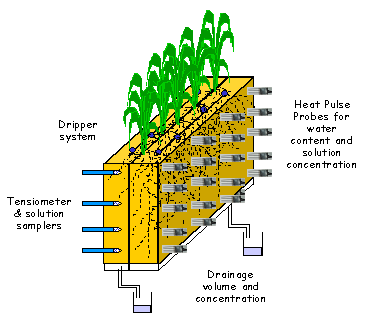DEVELOPMENT OF MULTI-FUNCTIONAL HEAT PULSE PROBE FOR ECOLOGICAL AND HYDROLOGICAL MONITORING OF PLANT ROOT ZONES

Atac Tuli, Project Manager, UCD: atuli@ucdavis.edu
Investigators:
Jan W. Hopmans, Department
Land, Air and Water Resources, University of California Davis
jwhopmans@ucdavis.edu
Ben Shaw, Mechanical Engineering, University of California Davis, Website
bdshaw@ucdavis.edu
Greg Pasternack, University of California Davis, Website
gpast@ucdavis.edu
Jirka Simunek, University of California Riverside, Website
Email: jiri.simunek@ucr.edu
Gerard Kluitenberg, Kansas State University, Website
gjk@ksu.edu
Antonio Valente, ITAD, Portugal
Publications to date:
Hopmans, Jan W., K.L. Bristow, and J. Simunek. 2001. Indirect estimation
of soil thermal properties and water flux from heat pulse measurements:
Geometry and dispersion effects. Water Resources Research 38(1):7-1 to
7-14: DOWNLOAD:
PDF
Mori, Y., J.W. Hopmans, A.P. Mortensen, and G.J. Kluitenberg. 2003. Multi-functional heat pulse probe for the simultaneous measurement of soil water content, solute concentration and heat transport parameters. Vadose Zone Journal DOWNLOAD: PDF
Mori, Y., J.W. Hopmans, A.Mortensen and G.J. Kluitenberg. 2005. Estimation of vadose zone water flux from multi-functional heat pulse probe measurements. Soil Sci. Soc. Amer. J; DOWNLOAD: PDF
Mortensen, A., J.W. Hopmans, Y. Mori and J. Simunek. 2005. Inverse modeling of water, heat, and solute transport in the vadose zone applying a multi-functional heat pulse technique. Advances in Water Resources.
Project Description:
In ecological, soil hydrological and related environmental sciences, there is a pressing need for improved instrumentation to augment the general understanding of water flow, nutrient/chemical and heat transport processes in rooting zones, vadose zone, and ground water. Specifically, innovative integrated laboratory and field measurement techniques are required to measure and monitor multiple soil environmental parameters using a single sensor, to minimize the effects of sampling volume and soil heterogeneity on the measurements. This proposal extends the ongoing laboratory development of a multi-functional (MF) heat pulse probe (HPP) to the field. The specific objectives of the proposed research are two-fold. First, to further develop and test the MF-HPP probe method for simultaneous measurement of bulk soil thermal, water flow and solute transport properties, and applying the MF-HPP in root chamber experiments to measure root water and nitrate uptake in water-limited ecosystems. Second, to design, develop and test a robust MF-HPP with wireless data transmission capabilities for remote in situ field applications, and to apply the in situ sensor to study water, nitrate and heat fluxes in plant root zones of both natural and agricultural ecosystems.

The MF-HPP provides a single sensor that measures soil temperature, soil moisture, soil nutrient concentration, soil water and heat fluxes. This sensor will be unique, considering that studies coupling soil hydrological with plant ecological processes requires estimation of water, solute and heat fluxes that can otherwise not be directly determined. The MF-HPP will be applied in plant root zones to better understand root uptake mechanisms of water and nutrients under water-limited soil environmental conditions. This will be done by combining the MF-HPP measurements with recently-developed numerical simulation models that couple the highly nonlinear multi-dimensional unsaturated water flow, nutrient, and heat transport equations with plant water and nutrient uptake using inverse modeling (IM). The proposed field design of the MF-HPP sensor will be installed in five different ongoing field sites to (1) to estimate plant root water and nitrogen uptake and leaching to ground water in a Australian sugar cane and a Japanese rice field, (2) to augment data on nitrogen and carbon cycling in an agricultural ecosystem in California’s Sacramento Valley, providing much-needed information on the potential of soil C-sequestration, and (3) to study eco-hydrological processes in a vernal pool habitat and a natural floodplain.
The intellectual merit of the proposed MF-HPP lies in the combination of various innovative measurement techniques that combined will (1) resolve measurement uncertainty issues that result from soil heterogeneities, and (2) provide for an essential new field approach that will advance the basic understanding of the coupled flow and transport of flow, chemicals and nutrients, and heat in plant root zones. The proposed application to study root water and nutrient uptake fluxes is significant in both ecological, soil hydrological and environmental sciences. A better understanding of plant uptake mechanisms under stressed conditions of water and nutrient availability will provide a solid basis for improved understanding and management of natural ecosystems and optimizing crop production systems through minimal environmental impacts. Among others, the resulting innovative water and soil management practices will minimize plant nutrient leaching to the groundwater (e.g. nitrates), better understand greenhouse gas emissions to the atmosphere, and provide much-needed information on plant adaptation in water-limited soil conditions.
The broader impacts of the proposed HPP development are both educational as well as scientific. Through the already established infrastructure of REMOTE (Real-time Educational Monitoring Of The Environment) at UC Davis, application of telemetry for wireless data transmission will make in-situ environmental data, in both numerical and graphical form, available to K-12 students and for undergraduate and graduate class instruction. We propose to link some of the developed software to a web-page, so that they become widely available on-line. Moreover, the MF- HPP can serve many direct practical applications, for ecological, agricultural, environmental, and geophysical investigations. The proposed research team of experts in soil physics, hydrology, engineering and plant-water relations will provide state-of-the-art technology available for scientists and teachers around the world, integrating research with education. The proposed research will be interdisciplinary with national and international collaborations, already ongoing through collaborations of University of California scientists with the co-investigators in the US, Japan and Australia.